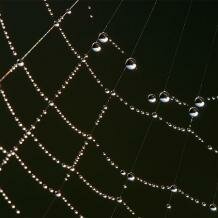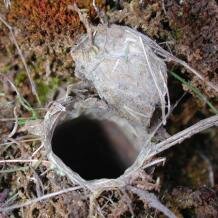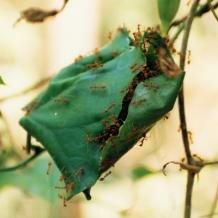Topic: Silk production and use in arthropods
Remarkably, fossil silk is known, especially from amber of Cretaceous age. Material includes both silk with trapped insects, possibly from an orb-web, and strands with the characteristic viscid droplets that are the key in trapping prey.
 Silk is one of the most remarkable of biomaterials known, with some varieties having mechanical properties that approach that of tensile steel, but achieved at a fraction of the weight. Silk is rampantly convergent, and has evolved many times. Although all the examples known are from the arthropods, there are two reasons to regard this as examples of independent evolution rather than ultimately stemming from a common ancestor. First, the distribution of silks in the arthropods is very disparate, notably in the arachnids (spiders and relatives) and the insects (e.g. silk-worm); the insects, for example, are closely related to the crustaceans which are not known to make silk. Second, silk structures (fibroins) are found in other groups, notably the byssus of the bivalve molluscs, where they evidently contribute to the extraordinary mechanical properties of these threads that serve to attach the bivalve to the substrate: securing mussels to rocks may be the best known example. Another example is the use of adhesive fibroin units in the ocites layer of the eggs of such fish as the carp, which are used to attach the eggs to a substrate of flowing water.
Silk is one of the most remarkable of biomaterials known, with some varieties having mechanical properties that approach that of tensile steel, but achieved at a fraction of the weight. Silk is rampantly convergent, and has evolved many times. Although all the examples known are from the arthropods, there are two reasons to regard this as examples of independent evolution rather than ultimately stemming from a common ancestor. First, the distribution of silks in the arthropods is very disparate, notably in the arachnids (spiders and relatives) and the insects (e.g. silk-worm); the insects, for example, are closely related to the crustaceans which are not known to make silk. Second, silk structures (fibroins) are found in other groups, notably the byssus of the bivalve molluscs, where they evidently contribute to the extraordinary mechanical properties of these threads that serve to attach the bivalve to the substrate: securing mussels to rocks may be the best known example. Another example is the use of adhesive fibroin units in the ocites layer of the eggs of such fish as the carp, which are used to attach the eggs to a substrate of flowing water.
Silk structure and composition
Silk is a fibrous protein, and is secreted from glands located in many different areas of the arthropod. It is extruded as a liquid, typically via a nozzle-like arrangement (such as the spinnerets in spiders), and then forms a remarkable thread that is in part crystalline. There are a very wide variety of silks, and the different mechanical properties are largely controlled by the amino acid compositions. The amino acids glycine (G) and alanine (A) are particularly common, and very often sections of the silk are determined by characteristic motifs of repetitive G or A, and another amino acid (X) e.g. AAX, GXG, etc. Spiders produce the widest repertoire of silks, with some species producing five or more varieties (each from a specific gland) with specific properties in web constructure e.g. drag-line, capture threads, etc.
 Silk in web construction and other functions
Silk in web construction and other functions
Silk is probably best known in the construction of webs, and these are also convergent because equivalent aquatic varieties are constructed by trichopteran insects, the caddisflies. Silk is also widely employed in functions as diverse as other sorts of traps to webs (“flypapers”), cocoon formation (as in Bombyx, the silkworm), egg coverings, domiciles, hunting (as in spitting), ballooning, escape lines and draglines, weaving (notably the weaver ants), and nuptial gifts.
Evolution of spider web silk
 Not surprisingly silk is geologically ancient. Spinnerets from the Middle Devonian evidently belong to a primitive spider, but in the absence of flying insects it is more likely that the silk produced was to line a burrow (or similar) rather than construct a web. Remarkably, fossil silk is also known, especially from amber of Cretaceous age. Material includes both silk with trapped insects, possibly from an orb-web, and strands with the characteristic viscid droplets that are the key in trapping prey (this example might be from a gum foot web).
Not surprisingly silk is geologically ancient. Spinnerets from the Middle Devonian evidently belong to a primitive spider, but in the absence of flying insects it is more likely that the silk produced was to line a burrow (or similar) rather than construct a web. Remarkably, fossil silk is also known, especially from amber of Cretaceous age. Material includes both silk with trapped insects, possibly from an orb-web, and strands with the characteristic viscid droplets that are the key in trapping prey (this example might be from a gum foot web).
Spider silk has received extensive attention, not only because of its intrinsic interest but also on account of potential biotechnological applications. The more primitive arrangement of web construction is found in the so-called cribellate spiders, so-called because of a spinning plate (the cribellum) located on the abdomen, and across which the silk is drawn. In what appears to be its most primitive arrangement the silk is a simple strand, and its adhesion depends on the same mechanism as the adhesive pads of the gecko lizards (and indeed the scopula of spiders), that is the application of Van der Waals molecular forces. More often, however, the cribellate silk thread is expanded into characteristic “puffs” and these also draw upon hygroscopic forces dependent on moisture for adhesion.
An extraordinary evolutionary breakthrough, however, led to a much more effective type of capture silk, both in terms of ease and economy of production. So successful is it that the vast majority of spider species employ it in so-called viscid thread. The trick lies in applying a layer of liquid on the outside of the silk, and this spontaneously collapses into a sense of droplets (an instability first recognized by the great physicist Lord Raleigh). The droplets are sticky and ingeniously have osmotic properties, widely adopted in other organisms, that prevent evaporation.
Spider web construction and capture devices
The web construction provides many other interesting evolutionary insights. It is possible that the orb-web construction is convergent.  In particular, although molecular data suggest that the araneoids (which build a viscid orb-web) and the cribellate deinopoids are related in such a way that only one origin of an orb-web needs to be postulated it needs to be remembered that orb-web building is a behaviour and it seems possible that it emerged independently.
In particular, although molecular data suggest that the araneoids (which build a viscid orb-web) and the cribellate deinopoids are related in such a way that only one origin of an orb-web needs to be postulated it needs to be remembered that orb-web building is a behaviour and it seems possible that it emerged independently.
Another fascinating area of web design is to do with the capture of moths. This is particularly problematic because the body and wings of the moth are covered with scales, and these readily detach on contact with the web, so allowing the moth to escape. At least two solutions to this dilemma have evolved. One is to construct a so-called ladder web (and this has probably evolved more than once) whereby above the orb itself there is an extraordinary “ladder” that can be 70 cm in length. Vertically arranged it ensures that when a moth blunders into the ladder it falls successively downward, leaving a trail of scales, and eventually adhering to the web.
Even more extraordinary are the bolas spiders, and these are worthy of attention because in addition to their unusual web construction they provide an excellent example of molecular convergence in the form of chemical mimicry of pheromones. Whilst not a true bolas in the form of releasing a rope of silk, the bolas spider makes a mud reduced trapeze-like web from which it sits, suspending a line of silk with a sticky droplet at the end. The droplet has a complex structure, and the outer layer is evidently very liquid and so can flow between the moth scales, while the centre contains a folder and apparently adhesive thread. It would seem that remarkable as this capturing device is, its chances of snaring a moth would be very low. So it would, except that the bolas spider manages an extraordinary chemical mimicry in the form of secreting the equivalent male moth pheromone. The male moth, of course, is attracted to what is a very sticky end. Equally remarkably the bolas spider can emit different pheromones to attract different species of moth, also adjusting concentrations according to what times of the night each species is most active.
Silk-producing chelicerates other than spiders
The ability to make silk has evolved at least twice more in the arachnids. The aptly named spider-mites (e.g. Tetranychus) are one example. These are well-known agricultural pests, and their silken webbing is familiar to plant pathologists. Interestingly the silk appears to have keratin-like features, keratin being the characteristic protein of hairs, hooves and claws. Silk is also made by some pseudoscorpions, including the marine neobisiids. Typically they make silk chambers that have a variety of functions including brooding and hibernation. It too has a keratin-like structure.
Silk-producing insects
Silk is also made by a wide variety of insects, probably best known in the lepidopterans, notably the eponymous silk-worm. In addition to being used to make cocoons silk-worm silk has other functions, including descent lines and also ballooning by larvae.
In the dipterans we find that silk may have a wide range of functions. In the fungus gnats, that have convergently evolved bioluminescence, the silk forms traps, either hanging from a web as a sort of “flypaper” (as in Arachnocampa) or located on the ground (in Orfelia). Dipterans, however, employ silk for other purposes, including the remarkable hilarinid flies (e.g. Hilara maura), members of the Empididae which in another group have a striking convergence in terms of raptorial fore-limb to the praying mantis. The silk-glands are located in the front (e.g. basitarsus), an arrangement that has independently evolved in the webspinners.  In the hilarinid the silk is made by the male, and used as a nuptial gift to the swarming females, hence their alternative name as dance flies. In the aquatic chironomid (midge) larvae the silk is used as draglines, to assist with snagging of the substrate.
In the hilarinid the silk is made by the male, and used as a nuptial gift to the swarming females, hence their alternative name as dance flies. In the aquatic chironomid (midge) larvae the silk is used as draglines, to assist with snagging of the substrate.
Silk is also made by ants, members of the Hymenoptera to which bees and wasps also belong. Silk production in ants is most familiar in the weaver ants, and evidently this ‘weaver’ ecology has evolved several times. As the name suggests weaver ants use the silk to bring leaves together to form nests, and the technique depends on the adult holding the larva which produces the silk and shuttling it backwards and forwards. However, silk is also produced in other groups of ants by the adult. Here it is used in nest construction. Other hymenopterans also make silk, including the larvae of bees and also wasps. Most likely these uses of silk are independent. The name webspinner, that is the group known as the embiopterans, is a clear indication of silk use, and in this primitive group silk plays a central role in nest construction.
Silk production is also known in the trichopterans, especially the aquatic formation of feeding web. Yet another group of insects that has learnt to make silk is a hemipteran, specially in the leafhopper, which constructs a waterproof tent.
Cite this web page
Map of Life - "Silk production and use in arthropods"
https://mapoflife.org/topics/topic_267_silk-production-and-use-in-arthropods/
March 4, 2021

